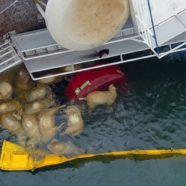Lubrizol worldwide
Production sites, accidents, and pollution
10 décembre 2019
In this exclusive document, Robin des Bois provides an overview of all the worldwide past and recent activities of Lubrizol. The inventory of the 60 plants is nearly exhaustive. However, the list of occupational accidents, operational accidents and pollution cases is hindered by the insufficient availability of open sources, particularly in Asia, the Middle-East, and Brazil.












